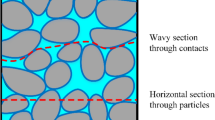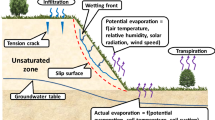Abstract
Deformation and failure of soils are governed by the stresses acting on the soil skeleton. The isotropic stress acting on the soil skeleton can be divided into two components. One is the stress component which is transmitted through the soil skeleton. This skeleton stress is influenced by the pore water (“bulk water”) in the soil. The other is the internal stress component which does not contribute to equilibrium with a given external force. The internal stress is induced by the capillary tension of meniscus water clinging to the contact point of soil particles and acts so as to connect the soil particles tightly. Therefore, in modeling the stress and strain relations for unsaturated soils, it is of much importance to quantitatively evaluate how the pore water exists in the soil. This paper discusses the role of pore water on the mechanical behaviour of the soil. In particular, the significance of the water retention curve is emphasized from a mechanical viewpoint. Essential features required in modeling of the constitutive relations for unsaturated soils are discussed and presented.
Similar content being viewed by others
References
Alonso, E. E., Gens, A. and Hight, D. W. (1987) Special problem soils. General Report. Prod. 9th European Conf. Soil Mechanics and Foundation Eng., 00, 1087–1146.
Alonso, E. E., Gens, A. and Josa, A. (1990) A constitutive model for partially saturated soils. Geotechnique, 40(3), 405–430.
Bishop, A. W. (1959) The principle of effective stress, Teknisk Ukeblad no. 39, pp. 859–863.
Bishop, A. W., Alpan, I., Blight, G. E. and Donald, I. B. (1960) Factors controlling the strength of partly saturated cohesive soils. Proc. Conf. Shear Strength of Cohesive Soils, ASCE: 503–532, 1027 1042.
Brooks, R. H. and Corey, A. T. (1966) Properties of porous media affecting fluid flow. Proc. ASCE, 92.IR(92): 61–88.
Honda, M. (2000) Method of predicting mechanical behavior of unsaturated foundation ground (in Japanese). Ph.D thesis, Kobe University.
Jennings, J. E. and Burland, J. B. (1962) Limitation to the use of effective stress in partly saturated soils, Geotechnique, 12(2), pp. 125–144.
Kraube, D. (1987) Basic stress-strain relations of unsaturated soil. Proc. 8th Asian Conf. Soil Mechanics and Foundation Eng., 1, 49–52.
Kraube, D. (1988) New concept of effective stress in unsaturated soil and its proving test. Advanced Triaxial Testing of Soil and Rock, ASTM STP977: 539–552.
Kraube, D. and Kato, S. (1994) An ideal unsaturated soil and the Bishop's soil. Proc. 13th Int. Conf. Soil Mechanics and Foundation Eng., 1, 43–46.
Kraube, D. (1997) Stress analysis of unsaturated soil based on the driest curve. Proc. 14th Int. Conf. Soil Mechanics and Foundation Eng., 1, 333–336.
Karube, D., Kato, S., Honda, M. and Kawai, K. (1998) A constitutive model for unsaturated soil evaluating effects of soil moisture distribution. Proc. 2nd Int. Conf. on Unsaturated Soils, Beijing, 1, 485–490.
Kraube, D., Kato, S., Hamada, K. and Honda, M. (1996) The relationship between the medical behaviour and the state of pore-water in unsaturated soil. J. of Japanese Society of Civil Eng., no. 535/11134, pp. 83–92 (in Japanese).
Kawai, K., Karube, D. and Kato, S. (2000) The model of water retention curve considering effects of void ratio. Proc. Asian Conf. on Unsaturated Soils, Singapore, pp. 000–000.
Kohgo, Y., Nakano, M. and Miyazaki, T. (1993a) Theoretical aspects of constitutive modeling for unsaturated soils. Soils and Foundations, 33(4), 49–63.
Kohgo, Y., Nakano, M. and Miyazaki, T. (1993b) Verification of the generalized elasto-plastic model for unsaturated soils. Soils and Foundations, 33(4), 64–73.
Leong, E. C. and Rahardjo, H. (1997) Review of soil water characteristic curve equations. J. of Geotechnical and Geoenvironmental Engineering, 123(12), 1106–1117.
Matyas, E. L. and Radhakrishna, H. S. (1968) Volume change characteristics of partially saturated soils. Geotechnique, 18, 432–448.
Mindlin, R.D. (1949) Compliance of elastic bodies in contact, J. of AppliedMechanics, 16, pp. 259–268.
Toll, D. G. (1995) A conceptual model for the drying and wetting of soils. Proc. 1st Int. Conf. on Unsaturated Soils, Paris, 2, 805–810.
Roscoe, K. H., Schofield, A. N. and Thuraiajah (1963) Yielding of clays in the state wetter than critical, Geotechnique, 13(3), 211–240.
Vanapalli, S. K., Fredlund, D. G., Pufahl, M. D. and Clifton, A. W. (1996) Model for prediction of shear strength with respect to soil suction, Canadian Geotechnical Journal, 33(3), pp. 379–392.
Wheeler, S. J. and Karube, D. (1995) Constitutive modeling. State of the Art Report. Proc. 1st Int. Conf. on Unsaturated Soils, Paris, 3, 1323–1356.
Author information
Authors and Affiliations
Rights and permissions
About this article
Cite this article
Karube, D., Kawai, K. The role of pore water in the mechanical behavior of unsaturated soils. Geotechnical and Geological Engineering 19, 211–241 (2001). https://doi.org/10.1023/A:1013188200053
Issue Date:
DOI: https://doi.org/10.1023/A:1013188200053




